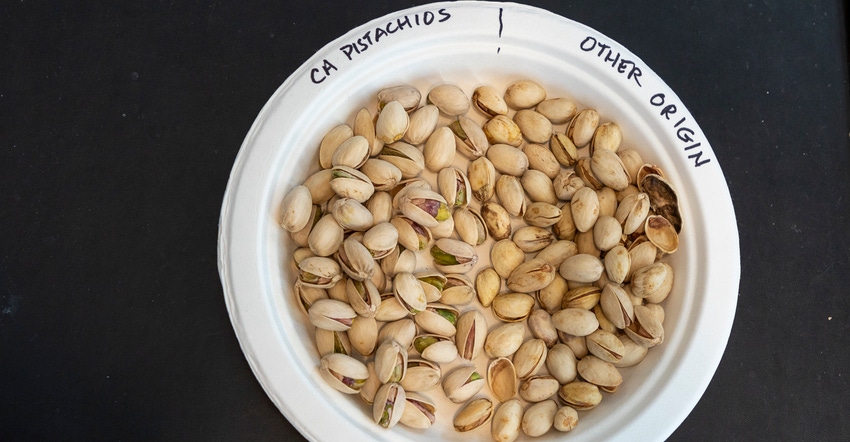
U.S. pistachio exports to China have never been higher, according to the voluntary trade association that markets the commodity globally. Still, the organization wonders “what could have been” as stiff tariffs remain.
Exports of pistachios to China and Hong Kong totaled more than 246 million pounds in the crop year that ended Aug. 31. This is up from the 180 million pounds shipped there the previous crop year.
Why the change amidst escalating tariffs and the tit-for-tat trade war reported between the United States and China?
Officials with the American Pistachio Growers in Fresno, Calif. say a bit of good fortune is at least part of the answer as Iran, America’s chief competitor in world pistachio markets, had a terrible production year in the previous season. Richard Matoian, executive director for APG, said a massive freeze affected pistachio production in the region, giving U.S. pistachio growers a leg up on world markets that year.
The United Nations reports that Iran produced nearly 575,000 metric tons of pistachios in 2017, more than double U.S. production that year of just over 272,000 metric tons. Most of the U.S. production comes from California with the balance of the American crop grown in Arizona and New Mexico.
Still, APG is working to boost U.S. pistachio sales around the world and is finding success in large global markets like China and India, says Judy Hirigoyen, vice president of global marketing for the association.
Asian markets
Haiying Zhang is the director of Asian markets with APG. While she views the latest reports of record shipments to China as a good thing for American pistachio farmers, she still asks what could have been. Did the additional tariffs on pistachios, now 55 percent for U.S. raw pistachios going to China have a dampening effect on shipments there? Could that 246 million pounds of pistachios have been higher, and by how much, she asks.
Despite the political disputes between the two countries, “we continued with our marketing activities to China,” Zhang said. “Our job is to build demand.”
Additionally, Zhang praised U.S. pistachio processors for their efforts to sell pistachios and supply consumer markets with quality product.
Within that marketing program, APG continues to market the health profile of pistachios to Chinese consumers, pointing to a recent study of the benefits pistachios can play in controlling gestational diabetes. The study points to a normalization of blood sugar in pregnant women who consume a regular diet of pistachios.
India
India is an up and coming market for American pistachios that is seeing positive results from relationships built with buyers in that country, according to Hirigoyen.
India has traditionally been a consumer of Iranian pistachios, Hirigoyen says. Efforts by U.S. interests, including APG, are helping buyers there see the value and quality of American grown pistachios. In the 2018/19 crop year, U.S. exports of pistachios to India totaled more than 18 million pounds, three times the shipments sent there the previous crop year.
Within APG’s marketing efforts to India, which is a continuation of APG’s “The Power of Pistachios” campaign, is the message that pistachios carry as much protein as an egg. This is important because about 80 percent of the Indian population eats a vegetarian diet.
“Our first message in India was to promote the protein,” Hirigoyen said.
They’re doing this through full page advertising in print media sold to Indian consumers, and increasingly through digital sources. APG has purchased 111 full-page print advertisements across India, helped with retail promotions in nine chains and one online platform, sought advertorials from top nutritionists that appeared in newspapers across the country, and assisted with various public relations programs.
The organization was recently awarded a $2.7 million grant from the U.S. Department of Agriculture aimed at helping American agriculture promote their products globally. This money will go to aid in the generic marketing programs APG is involved with, Hirigoyen said.
The Indian campaign is also using U.S. pistachio farmers whose families immigrated here from India to tell a story of success, and of the value of consuming pistachios.
Because India has the youngest population in the world – the average age is 29, with about 60 percent of the population below the age of 35, this creates incredible opportunity for the American pistachio industry, said one of that country’s largest importers of tree nuts in a video produced by APG.
Hirigoyen showed some samples of pistachios collected abroad that come from other countries and compared them to U.S. pistachios. The staining on foreign pistachio shells, the foreign matter in these bags that included peanut shells, and the mislabeling of a bag of pistachios with words in German declaring the product inside to be hazelnuts all give Hirigoyen a chuckle and a sense that America’s strict standards when it comes to food safety and labeling can help aid her mission to sell more American pistachios globally.
All exports of U.S. pistachios in the 2018/19 crop year totaled 578 million pounds, up from the previous high of 436 million pounds.
Hirigoyen is optimistic about the campaign and its reach to Indian consumers because of what she’s already seen, and because of the efforts of APG members whose families came here from India within the past 50 years. Included in that message is print advertising featuring photos of descendants of these families who now reside in California, and whose families harvest pistachios in the Central Valley.
About the Author(s)
You May Also Like






